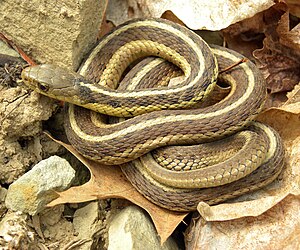Common garter snake
| Common garter snake | ||||||||||||
|---|---|---|---|---|---|---|---|---|---|---|---|---|

Ordinary garter snake |
||||||||||||
| Systematics | ||||||||||||
|
||||||||||||
| Scientific name | ||||||||||||
| Thamnophis sirtalis | ||||||||||||
| ( Linnaeus , 1758) |
The common garter snake ( Thamnophis sirtalis ) is the best known snake species within the genus Garter Snake ( Thamnophis ).
features
The 12 subspecies of the common garter snake differ among other things in a variety of color variations. What they all have in common are the mostly brightly contrasting back and side stripes, to which the genus owes the name garter snake. The females are usually one meter long, sometimes up to 1.20 m. Males rarely reach a length of more than 60 cm.
food
They have a wide range of foods and will eat fish , slugs , worms , amphibians , mice , rats and even small birds . A special feature of this snake species is that it is one of the few, if not the only natural enemy of the rough-skinned yellow-bellied newt ( Taricha granulosa ). In the course of evolution , she developed an immunity against the highly toxic defense substance of this salamander , the tetrodotoxin (TTX, also known under the name tarichatoxin). After eating the salamander, it will go into a dormant state and slow down its metabolism so that it can compensate for the effects of this poison. It is probably the only organism that can survive after ingesting this poison. It is a coevolution between the newt and the snake species. In regions where this snake can be found, the production of tetrodotoxin of the newt is increased and in return the resistance of the snake has increased. One speaks of the “geographic mosaic theory of evolution”.
Reproduction
Unlike most snakes , garter snakes are viviparous ( ovoviviparous ). Your young animals are already fully developed when they lay their eggs and are only surrounded by a thin, transparent egg shell. This shell must be pierced by the young animals during or immediately after birth, otherwise they will suffocate. A garter snake litter usually contains five to twenty young animals. In individual cases, however, litter sizes of more than 80 young animals have been observed.
distribution
In North America the common garter snake is the most widespread reptile species. In Alaska it is the only species of snake at all. Their habitat extends south to Mexico in Central America .
Subspecies
- Texan garter snake ( T. sirtalis annectens )
- Red-spotted garter snake ( T. sirtalis concinnus )
- New Mexico garter snake ( T. sirtalis dorsalis )
- California garter snake ( T. sirtalis fitchi )
- California red-sided garter snake ( T. sirtalis infernalis )
- T. sirtalis lowei
- Quebec garter snake ( T. sirtalis pallidulus )
- Red-sided garter snake ( T. sirtalis parietalis )
- Pickering's garter snake ( T. sirtalis pickeringii )
- Chicago garter snake ( T. sirtalis semifasciatus )
- Florida garter snake ( T. sirtalis similis )
- Eastern garter snake ( T. sirtalis sirtalis )
- San Francisco garter snake ( T. sirtalis tetrataenia )
The subspecies status of T. s. similis and T. s. semifasciatus is controversial.
swell
- ↑ Edmund D. Brodie Jr., BJ Ridenhour, ED Brodie III: The evolutionary response of predators to dangerous prey: hotspots and coldspots in the geographic mosaic of coevolution between garter snakes and newts. - Evolution 56 (10), pp. 2067-2082 (2002) BioOne Online Journals
literature
- Thomas Bourguignon: Garter Snakes. Origin, care, species , DATZ terrarium books, 2002, ISBN 3-8001-3591-4
- Martin Hallmen, Jürgen Chlebowy: Garter Snakes , Nature and Animal Publishing, 2001, ISBN 3-931-58749-5
- WP Mara: Garter Snakes in the Terrarium , paperback (63 pages), Bede Verlag, 1995, ISBN 3-927-99779-X
- Frank Mutschmann : The garter snakes. Biology, distribution, keeping , paperback (172 pages), Westarp-Verlag, 1995, ISBN 3-894-32427-9
- Thomas Bourguignon: The garter snake Thamnophis sirtalis. In: Reptilia. 12. 1998, pp. 39-42
- Hallmen, M. & Chlebowy, J .: Garter Snakes , Variety of a Classic. In: Reptilia. 23, 2000, pp. 16-21
Web links
- Thamnophis sirtalis in The Reptile Database
- Thamnophis sirtalis inthe IUCN 2013 Red List of Threatened Species . Posted by: Frost, DR, Hammerson, GA & Santos-Barrera, G., 2007. Retrieved September 21, 2013.